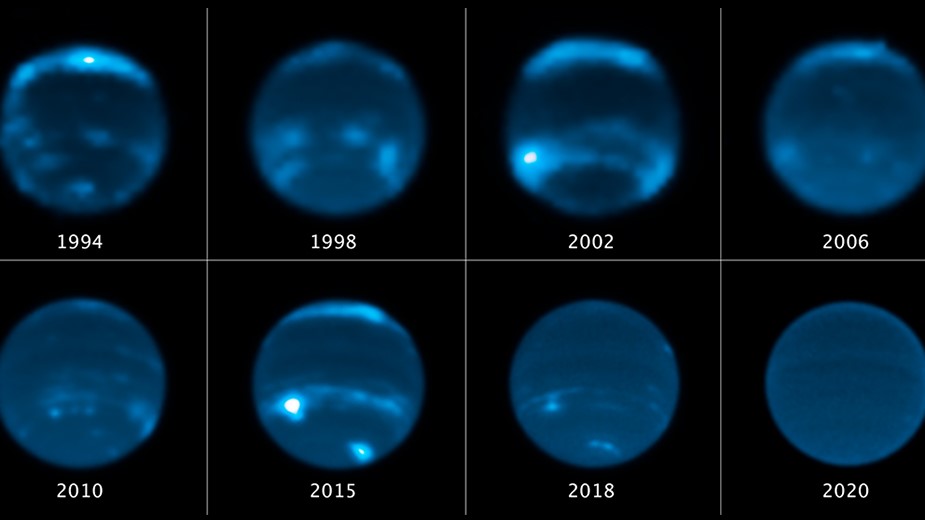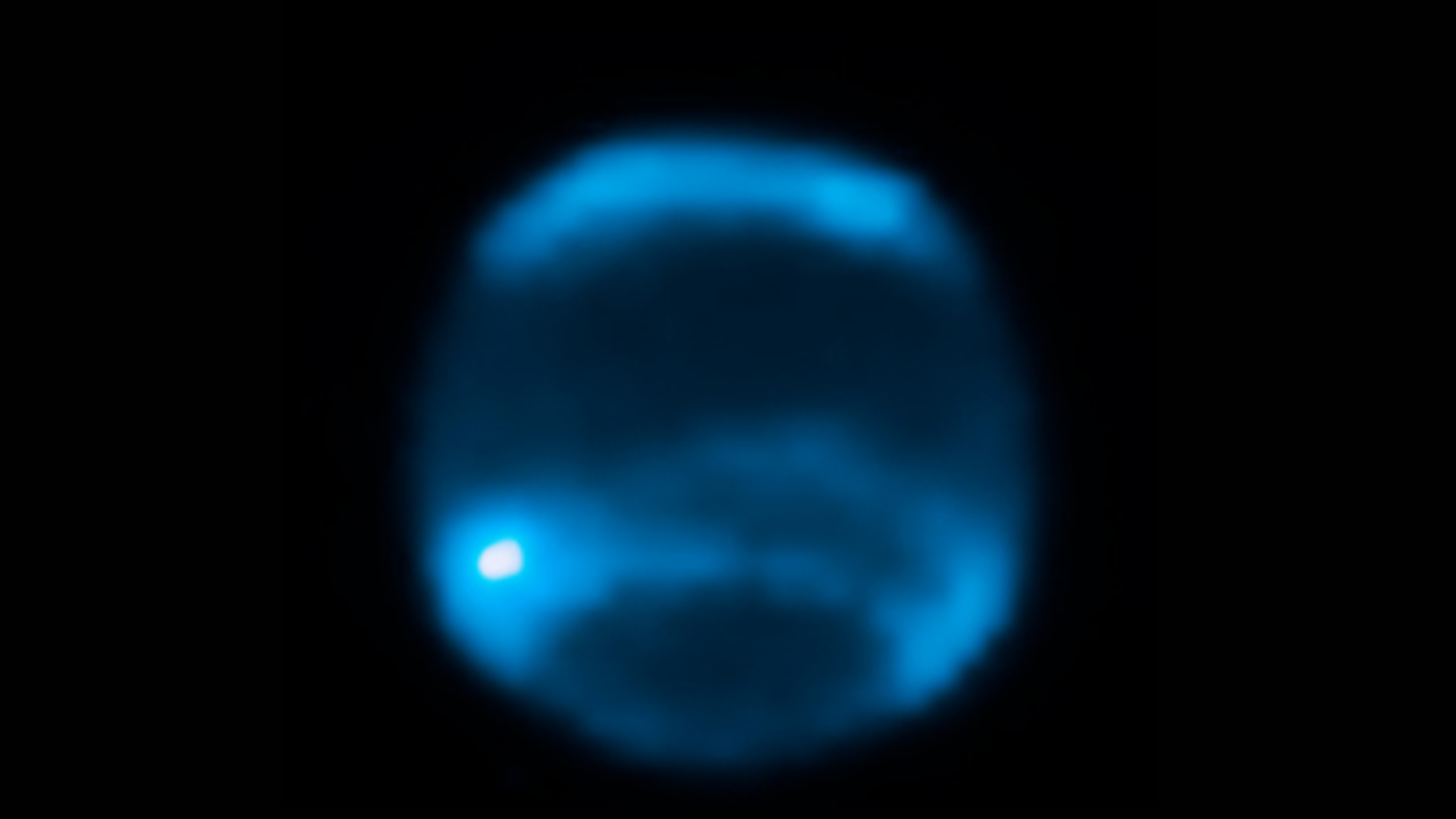
On Thursday (Aug. 17), astronomers announced quite an unexpected update about one of our solar system's ice giants, Neptune: It would appear that the azure world's clouds have all but disappeared.
Basically, after looking at images taken of the planet between the years 1994 and 2022, the team noticed a strange pattern beginning in 2019. Around the planet's mid-latitudes, cloud coverage seemed to start fading. Eventually, all evidence of clouds totally vanished.
"I was surprised by how quickly clouds disappeared on Neptune," Imke de Pater, an emeritus professor of astronomy at the University of California, Berkeley and senior author of a study on the findings, said in a statement. "We essentially saw cloud activity drop within a few months."
Intrigued by this discovery, de Pater and fellow researchers decided to dig deeper. And, sure enough, they came up with a rather fascinating explanation. It's likely, the team suggests, that Neptune's clouds are inextricably linked with the way our sun behaves during its 11-year-long activity cycle.
What do you mean it's the sun's fault?
The solar cycle, in essence, refers to the way our host star's magnetic fields change over the course of time — specifically, over 11 years.
Despite what it looks like, the sun isn't exactly a blazing hot chunk of land. Rather, it's more of a giant, orb-shaped ocean made of charged particles, collectively known as plasma, which means its structure can generally flow around and mold itself over time. In conjunction with such movement, the sun's magnetic fields, directly associated with all those charged particles, get tangled up.
As these fields get tangled, they exert more and more "tension" on our host star, so to speak, until the yellow glowing ball can't handle it anymore. Then, every 11 years, sort of as a reset, the sun's magnetic fields flip, meaning the north pole becomes the south pole and vice versa. From there, the saga repeats itself.
Related: NASA's New Horizons will investigate Uranus from the rear (Neptune, too). Here's how you can help
During those 11 years, though, other types of things happen due to magnetic field alterations, too. For instance, magnetic-field knots can lead to an increased number and intensity of solar flares, which are incredibly powerful ejections of radiation out into space. These flares can sometimes be so strong they even interfere with Earth-orbiting satellites. And they're often associated with giant eruptions of solar plasma known as coronal mass ejections, which can shower our planet with charged particles that create temporary mini-blips in communication lines.
But most importantly for the team's Neptune analysis, one phenomenon known to happen during the solar cycle is that the sun emits a bunch of ultraviolet radiation as its magnetic fields transition. Considering how utterly massive the sun is, that radiation sort of "floods" the rest of the solar system, as the researchers put it.
And naturally, it's easy to believe that this whole situation might affect a planet or two — including Neptune, even though the distant, windy planet sits some 2.8 billion miles (4.5 billion kilometers) from our beloved star.
Where does this leave Neptune?
To dissect where Neptune's clouds have gone, the team gathered 30 years of stunning images of the planet taken by powerful observatories, including NASA's Hubble Space Telescope and the W. M. Keck Observatory located in Hawaii.
What they found was that there seemed to be a clear correlation between the number of clouds on Neptune and the point at which our sun's solar cycle found itself. More specifically, approximately two years after the cycle's peak — aka, the main event of magnetic field flipping — Neptune exhibited some solid cloud coverage. It was only after that peak when the clouds appeared to fade away above the planet's hydrogen, helium and methane atmosphere. (That methane content is what makes Neptune look so very blue).
Potentially, this means the sun's UV radiation — strongest at solar peak — may be fostering a photochemical reaction, sparked by the absorption of energy in the form of light, to produce Neptune's cloudy cap.
And maybe that reaction takes something like, say, two years to take effect? This would explain why, two years post-solar peak, the team witnessed Neptunian clouds galore.
"These remarkable data give us the strongest evidence yet that Neptune's cloud cover correlates with the sun's cycle," de Pater said.

Furthermore, the team saw that the more clouds there were on this frozen blue world, the brighter it seemed to be, because there was more sunlight reflecting off those clouds.
"Potential correlations of variations in Neptune’s brightness with changing seasons and the solar activity cycle have been explored, but so far no single cause has been identified," the study authors wrote in their paper. "While seasonal effects are most likely important for the slow gradual changes, secular variations in brightness must have a different origin."
To get into a few details, these results are all the consequence of looking at 2.5 cycles of cloud activity recorded over the three-decade-long period of Neptune observations the team laid out. And during this time, in terms of that brightness finding, the researchers say that the planet's "reflectivity" increased in 2002, dimmed in 2007, became bright again in 2015, then darkened in 2020 — when the clouds seemed to have completely disappeared.
"Even now, four years later, the most recent images we took this past June still show the clouds haven't returned to their former levels," Erandi Chavez, a graduate student at the Center for Astrophysics, Harvard-Smithsonian and study lead, said in the statement. "This is extremely exciting and unexpected, especially since Neptune's previous period of low cloud activity was not nearly as dramatic and prolonged."
It's actually quite striking that all of these changes are clearly visible in the images provided by the team, further underlining the importance of maintaining observatories such as Keck and Hubble. "It’s fascinating to be able to use telescopes on Earth to study the climate of a world more than 2.5 billion miles away from us," Carlos Alvarez, an astronomer at Keck Observatory and co-author of the study, said in the statement.
In the future, Alvarez and colleagues will continue to watch Neptune's cloud activity to see when these cirrus-shaped features are on the return. In fact, over the past couple of years, as solar UV rays have increased a bit, they've been seeing some cloud resurgence already.
"We have seen more clouds in the most recent Keck images that were taken during the same time NASA's James Webb Space Telescope observed the planet," de Pater said. "These clouds were in particular seen at northern latitudes and at high altitudes, as expected from the observed increase in the solar UV flux over the past approximately two years."
Don't worry, Neptune: Your clouds shall return in due time.
A paper on these findings is available in the November issue of the journal Icarus.







